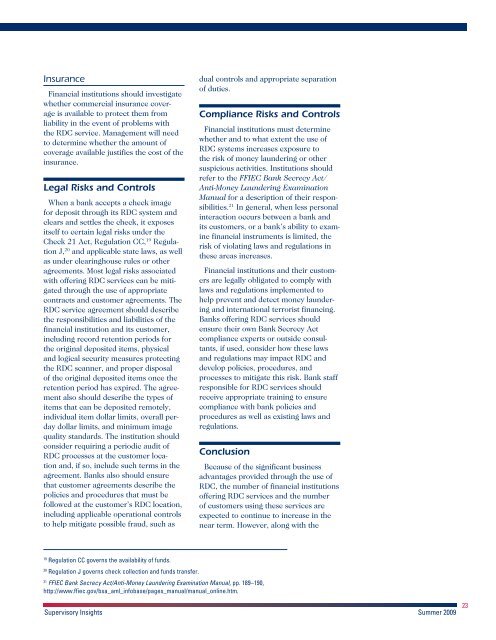FDIC Supervisory Insights Summer 2009
FDIC Supervisory Insights Summer 2009
FDIC Supervisory Insights Summer 2009
Create successful ePaper yourself
Turn your PDF publications into a flip-book with our unique Google optimized e-Paper software.
Insurance<br />
Financial institutions should investigate<br />
whether commercial insurance coverage<br />
is available to protect them from<br />
liability in the event of problems with<br />
the RDC service. Management will need<br />
to determine whether the amount of<br />
coverage available justifies the cost of the<br />
insurance.<br />
Legal Risks and Controls<br />
When a bank accepts a check image<br />
for deposit through its RDC system and<br />
clears and settles the check, it exposes<br />
itself to certain legal risks under the<br />
Check 21 Act, Regulation CC, 19 Regulation<br />
J, 20 and applicable state laws, as well<br />
as under clearinghouse rules or other<br />
agreements. Most legal risks associated<br />
with offering RDC services can be mitigated<br />
through the use of appropriate<br />
contracts and customer agreements. The<br />
RDC service agreement should describe<br />
the responsibilities and liabilities of the<br />
financial institution and its customer,<br />
including record retention periods for<br />
the original deposited items, physical<br />
and logical security measures protecting<br />
the RDC scanner, and proper disposal<br />
of the original deposited items once the<br />
retention period has expired. The agreement<br />
also should describe the types of<br />
items that can be deposited remotely,<br />
individual item dollar limits, overall perday<br />
dollar limits, and minimum image<br />
quality standards. The institution should<br />
consider requiring a periodic audit of<br />
RDC processes at the customer location<br />
and, if so, include such terms in the<br />
agreement. Banks also should ensure<br />
that customer agreements describe the<br />
policies and procedures that must be<br />
followed at the customer’s RDC location,<br />
including applicable operational controls<br />
to help mitigate possible fraud, such as<br />
19 Regulation CC governs the availability of funds.<br />
20 Regulation J governs check collection and funds transfer.<br />
dual controls and appropriate separation<br />
of duties.<br />
Compliance Risks and Controls<br />
Financial institutions must determine<br />
whether and to what extent the use of<br />
RDC systems increases exposure to<br />
the risk of money laundering or other<br />
suspicious activities. Institutions should<br />
refer to the FFIEC Bank Secrecy Act/<br />
Anti-Money Laundering Examination<br />
Manual for a description of their responsibilities.<br />
21 In general, when less personal<br />
interaction occurs between a bank and<br />
its customers, or a bank’s ability to examine<br />
financial instruments is limited, the<br />
risk of violating laws and regulations in<br />
these areas increases.<br />
Financial institutions and their customers<br />
are legally obligated to comply with<br />
laws and regulations implemented to<br />
help prevent and detect money laundering<br />
and international terrorist financing.<br />
Banks offering RDC services should<br />
ensure their own Bank Secrecy Act<br />
compliance experts or outside consultants,<br />
if used, consider how these laws<br />
and regulations may impact RDC and<br />
develop policies, procedures, and<br />
processes to mitigate this risk. Bank staff<br />
responsible for RDC services should<br />
receive appropriate training to ensure<br />
compliance with bank policies and<br />
procedures as well as existing laws and<br />
regulations.<br />
Conclusion<br />
21 FFIEC Bank Secrecy Act/Anti-Money Laundering Examination Manual, pp. 189–190,<br />
http://www.ffiec.gov/bsa_aml_infobase/pages_manual/manual_online.htm.<br />
Because of the significant business<br />
advantages provided through the use of<br />
RDC, the number of financial institutions<br />
offering RDC services and the number<br />
of customers using these services are<br />
expected to continue to increase in the<br />
near term. However, along with the<br />
<strong>Supervisory</strong> <strong>Insights</strong> <strong>Summer</strong> <strong>2009</strong><br />
23

















